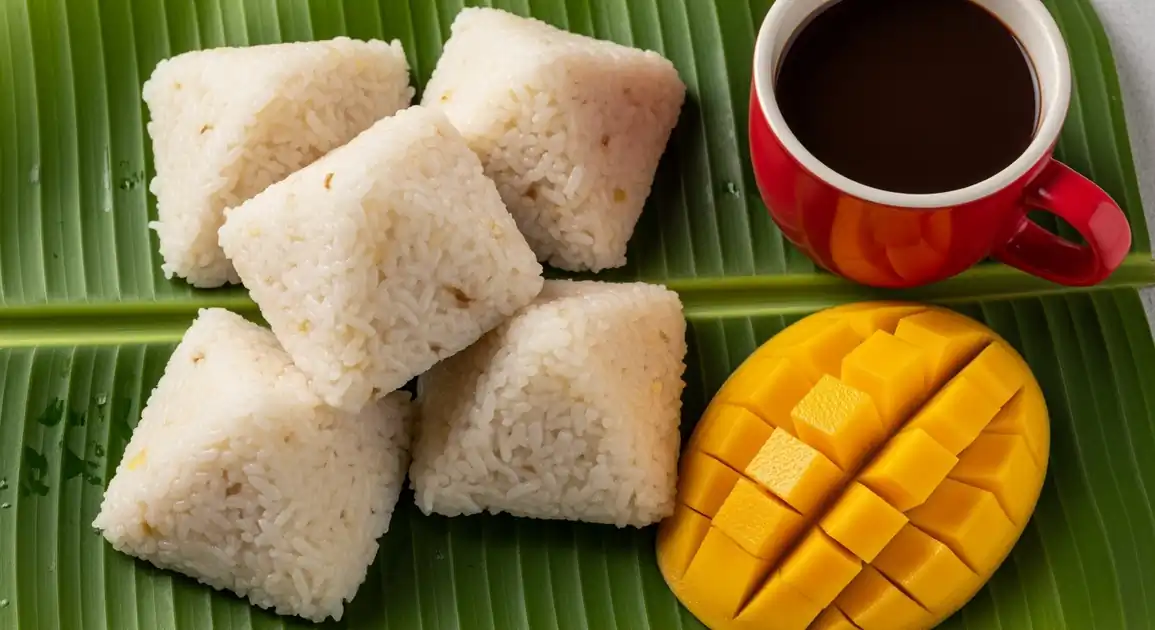Puto Maya
Puto Maya

Description
Bohol is widely recognized as the heartland of authentic Puto Maya. In this island province, this humble rice cake elevated with ginger and coconut milk reaches its highest form, especially in the capital city of Tagbilaran and surrounding towns. The complete Boholano breakfast experience of puto maya with sweet mango and sikwate (hot chocolate) is a culinary tradition that locals take pride in sharing with visitors.
Dietary Information
Serving information
Serving style
Traditionally served as a pyramid-shaped portion wrapped in banana leaf, accompanied by slices of ripe yellow mango and a small cup of sikwate. Many vendors in Bohol still maintain this authentic presentation, especially in markets.
Quick facts
Puto Maya vendors in Bohol typically operate from 5 AM - 11 AM, with market vendors starting earliest (around 4:30 AM) and tourist-area vendors continuing until slightly later.
Safety Tips
What to Look For
-
Freshly steamed puto maya with visible steam
Properly cooked puto maya should be steaming hot when served, indicating it's freshly made and has reached temperatures that kill potential pathogens.
-
Clean, covered containers or banana leaf wrapping
Quality vendors keep puto maya covered in bamboo steamers or wrapped in banana leaves, protecting it from contamination and preserving moisture.
-
Moist, sticky texture with visible ginger pieces
Good puto maya should be sticky and moist, not dry or crumbly. Visible ginger pieces indicate authentic preparation.
-
Vendors who prepare fresh batches throughout the morning
The best vendors make multiple small batches rather than one large batch that sits all day.
What to avoid
-
Dry, cracked surface or hardened texture
Indicates the puto maya is old, dried out, and potentially unsafe as it's been sitting out too long.
-
Room temperature puto maya with no reheating option
Freshly made puto maya should be warm. Room temperature offerings that aren't freshly made could harbor bacteria.
-
Discolored or yellowed appearance
Natural puto maya should be white to slightly off-white. Yellowing indicates aging or improper storage.
-
Strong sour smell or off odors
Fermentation can occur if left too long at room temperature. Good puto maya should smell primarily of coconut and ginger.
Price information
Price range
Budget tips
- Market vendors in Tagbilaran Public Market offer puto maya for ₱15-25 per serving.
- A complete set (puto maya, mango, sikwate) costs ₱40-60 at local markets.
- Tourist-oriented cafes like Gerarda's or Bohol Bee Farm serve gourmet versions for ₱80-120.
- Buying early (before 7 AM) often means fresher product and sometimes better prices.
Value indicators
- Authentic pyramid shape wrapped in banana leaf.
- Visible ginger pieces in the rice cake.
- Proper sticky consistency, neither too dry nor too wet.
- Rich aroma of both ginger and coconut.
- Sikwate made from local tablea, not commercial mixes.
Where to Find This Dish
Tagbilaran Public Market
The central section of the market has several vendors specializing in puto maya, operating in the early morning hours.
Main market building, Kakanin (rice cake) section, Native delicacies area
5 AM - 9 AM
Tagbilaran Port Area
Vendors near the pier cater to arriving tourists and locals, offering the complete breakfast experience.
Ferry terminal, Port entrance, Tourist information center
6 AM - 10 AM
Island City Mall Surroundings
Several small shops and stands near the mall sell puto maya to shoppers and locals.
Mall entrance, Transportation hub near mall
7 AM - 10 AM
Tourist Destinations
Areas near Chocolate Hills viewing points and Loboc River often have vendors selling to tourists.
Chocolate Hills Complex, Loboc River cruise starting points, Tarsier sanctuaries
7 AM - 11 AM
Vendor Tips
- Locals favor vendors who use traditional bamboo steamers rather than metal ones.
- Ask specifically for 'Boholano sikwate' to ensure you get the authentic tablea-based hot chocolate.
- Some vendors sell frozen puto maya as 'pasalubong' (souvenirs) – these are good for a day with proper refrigeration.
How to Order
Regional Variations
-
Tapol (Purple) Puto Maya
(Tapol na Puto Maya)
This distinctly Boholano variation uses black or purple glutinous rice, producing a dramatic color and slightly nuttier flavor. Especially popular in the eastern parts of Bohol.
-
Extra-Ginger Boholano Style
(Maluya na Puto Maya)
Some traditional Bohol vendors are known for using a more generous amount of ginger, creating a more pronounced spicy warmth in their version.
-
Tourist-friendly Plated Sets
(Puto Maya Espesyal)
Higher-end restaurants in Tagbilaran and Panglao serve elaborate presentations with premium mangoes, artisanal sikwate, and sometimes additional garnishes like toasted coconut flakes.
Cultural context
History
Puto Maya originated in the Visayas islands of the Philippines, with Bohol claiming it as a signature dish. While 'puto' generally refers to steamed rice cakes in Filipino cuisine (influenced by pre-colonial cooking techniques and trade with neighboring Asian countries), the 'maya' variant likely evolved from local preferences and available ingredients. The dish became a breakfast staple for farmers and workers, providing substantial morning energy through its carbohydrate-rich composition. Today, it's both an everyday breakfast food for locals and a cultural food experience actively promoted to tourists visiting Bohol.
Local significance
In Bohol, puto maya is more than food – it's a cultural ambassador and source of local pride. Boholanos consider their version, particularly served with the complete mango and sikwate pairing, to be the definitive preparation of this dish.
Eating customs
- Boholanos emphasize the importance of eating the three components (puto maya, mango, sikwate) together rather than separately.
- Many locals insist on using only the sweet yellow Carabao mango variety as the proper accompaniment.
- Traditional Boholano breakfast ritual often starts with sikwate to warm the stomach, followed by alternating bites of puto maya and mango.